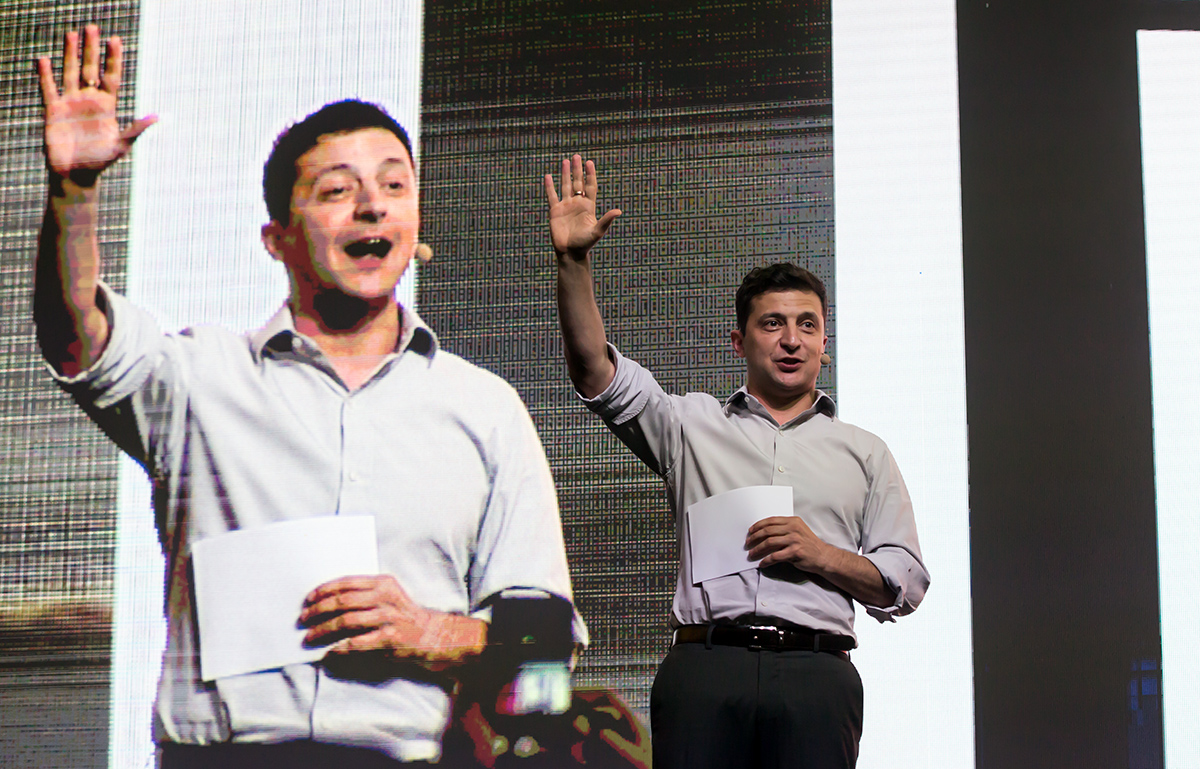
Making Sense of Ukraine’s Post-Election Landscape
Analysis. The 2019 presidential and parliamentary elections in Ukraine have fundamentally transformed the country’s political landscape. For the first time in its contemporary history Ukraine’s executive and legislative branches of power are firmly controlled by a single political force that had not existed in any shape or form at the start of the year. This highly unusual situation is fraught with potential instability as the current sky-high popularity of the newly elected president and his party may well prove to be short-lived, writes UI Fellow Igor Torbakov.
Publicerad: 2019-08-27
In one memorable episode from the extremely popular Ukrainian sitcom Servant of the People, Vasyl Petrovych Holoborodko, a modest history teacher, dressed only in his underwear, is sitting in his Soviet-era apartment waiting for his niece to vacate the bathroom. Suddenly three suited men appear on his porch and announce that he has just won Ukraine’s presidential election with 67 percent of the vote. Feeling somewhat outlandish, the whole scene is undeniably very funny.
However, on April 21, 2019, Volodymyr Zelensky, who played Holoborodko in the TV series, was elected Ukraine’s next president, winning 73 percent of the vote (compared to incumbent Petro Poroshenko’s 25 percent) and all but one of Ukraine’s regions. Three months later, on July 21, Zelensky’s political force, the Servant of the People party, pulled off yet another feat, winning 254 of 450 seats in the Verkhovna Rada, the national legislature. There’s no denying that this was a rather baffling political development. Yet this manifestation of seemingly eccentric politics à la ukrainien has also highlighted the sheer complexity of social processes evolving in this strategic East Slavic country since its political upheaval five years ago.
Like any other revolution, the 2014 Euromaidan has raised an extremely high bar of expectation. The mandate given to the new leaders by the people was both crystal clear and devilishly hard to fulfil: restoration of Ukraine’s territorial integrity and radical socio-political transformation bringing the country closer to EU standards. The political future and overall legitimacy of the Ukrainian leadership swept into power by the revolutionary wave have come to rest on its ability to deal with two major challenges: defending the country in the “hybrid war” in the eastern provinces and implementing a thoroughgoing reform in economic and social spheres.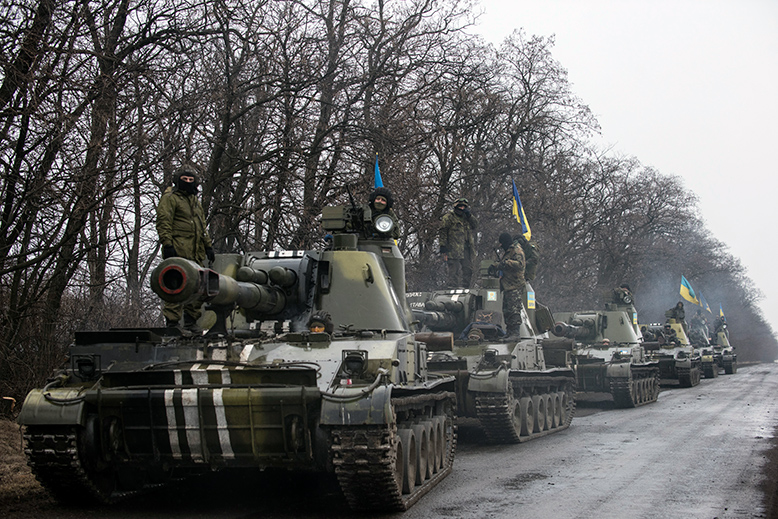 Movement of heavy weaponry in eastern Ukraine. Photo: OSCE Special Monitoring Mission to Ukraine/Creative Commons
Movement of heavy weaponry in eastern Ukraine. Photo: OSCE Special Monitoring Mission to Ukraine/Creative Commons
Five years on, the outcome appears to be a mixed bag on both counts. On the war front, Kyiv has ultimately succeeded in thwarting Moscow’s more ambitious, if downright fanciful, geopolitical designs aimed at splitting Ukraine into several parts, absorbing the south-eastern regions of “Novorossiia” directly into Mother Russia’s geo-body, installing a puppet regime in the other part, and hanging the rest out to dry. Kyiv’s success in stopping the external aggression and preserving the bulk of the nation’s territory intact is no mean feat, particularly given the dire straits that Ukrainian military found themselves in in the spring of 2014.
However, the Poroshenko government managed neither to recover parts of Donetsk and Luhansk regions lost to the Russia-backed rebels nor to find a comprehensive solution to the Donbas problem. In the short and medium run, the situation does not look promising. The “Minsk Accord” cannot be implemented as Ukraine and Russia interpret its clauses in diametrically opposite fashion, while the “Normandy format” seems to have degenerated into a discussion club, wielding no authority whatsoever.
As Ukrainian military got stuck in the exhausting trench warfare – the death toll has risen above 13,000 and the number of internally displaced persons fleeing war exceeds 1.8 million – the powers-that-be in Kyiv have stubbornly stuck to their official characterization of the confrontation as “anti-terrorist operation.” This makes for a highly ambiguous situation and the gap has been growing between the grim reality the Ukrainians see before their eyes and the rhetoric of the country’s governing elites.
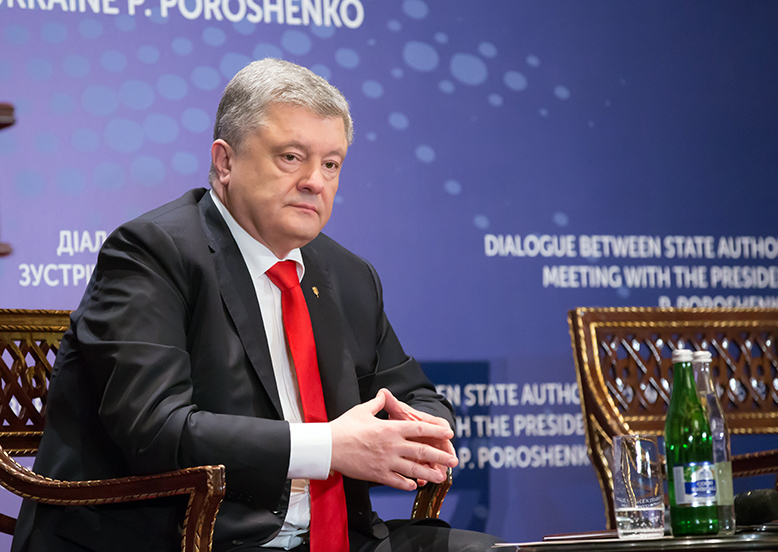 Petro Poroshenko. Photo: Shutterstock
Petro Poroshenko. Photo: Shutterstock
On the reform front, the picture appears to be equally ambivalent. Arguably, the last five years saw more meaningful reforms than all the previous years since 1991. Yet so far, the effect of these reforms has failed to translate into decent living standards. According to the recent Credit Suisse report, Ukraine ranks 123rd out of 140 countries in terms of its citizens’ median wealth. Education and healthcare reforms have not yet been completed and the crucial legal reform appears to have stalled.
Graft continues to be one of the country’s biggest problems. Polling data shows that around 90 percent of Ukrainians believe government corruption is widespread. Corruption in Ukraine, concurs the U.S. State Department, remains “pervasive at all levels in the executive, legislative, and judicial branches of government.”
What accounts for such a patchy picture? It would appear that Euromaidan failed to produce a critical mass of people who would get organized and resolutely act as agents of change. One of the many expectations five years ago was that a new movement, probably a new party of reform, would emerge out of Ukraine’s most recent political turmoil and change the underhand nature of Ukrainian politics. But Euromaidan did not create any such movement or party. Its most prominent activists chose to join the established political organizations. This was, in the words of the Lviv-based journalist and public intellectual Yuri Durkot, a “political failure of the Maidan generation.”
As a result, the old-new elites who found themselves in leadership positions in the aftermath of the 2014 electoral cycle have pursued a set of policies that was riddled with ambiguity. While on the rhetorical level they have upheld the objective of Ukraine’s comprehensive “Europeanization” (not least because no meaningful alternative to “Europeanization” exists), a significant segment of the country’s political class appeared to believe that it was possible to return to the “business as usual” mode once the most odious aspects of post-Soviet condition characteristic of the infamous Yanukovych reign had been removed.
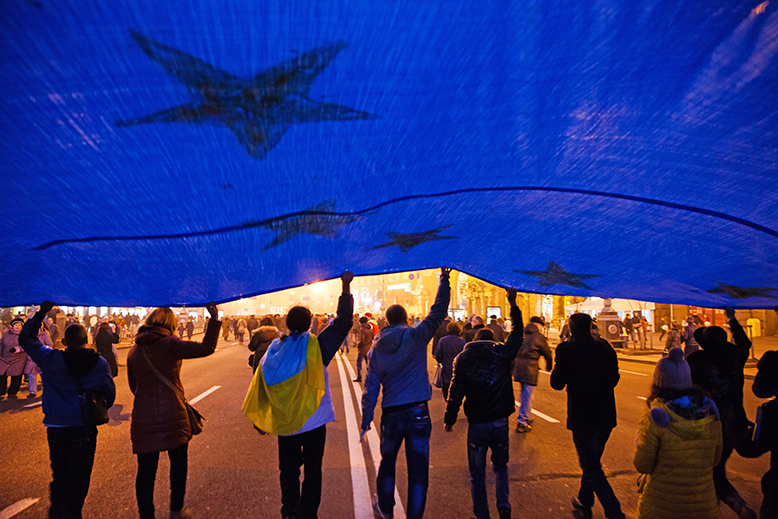 Mass meeting in Kiev for European integration, November 24, 2013. Photo: Shutterstock
Mass meeting in Kiev for European integration, November 24, 2013. Photo: Shutterstock
As Poroshenko’s presidential term was drawing to a close, elite attitudes and popular attitudes seemed to be increasingly out of synch. The bulk of Ukrainian elites had a sense that the revolution was over and they were basically back to their old ways. But large swaths of the Ukrainian population had a radically different vision. For them, the revolution was not over, simply because most of the goals set forth by Euromaidan – in particular, clean government and independent legal system – have not been achieved. A recent Gallup poll has neatly caught the popular mood: Ukraine ended up at the very bottom of the list of countries in terms of its citizens’ trust in national government: only 9 percent of respondents said they had trust in Ukraine’s state institutions.
The widening chasm between elite and popular visions underlies the “decimation” of Ukrainian political establishment in the course of the two rounds of the 2019 presidential election and a snap parliamentary election, with both races being won in a landslide by the “Team Ze.” In many ways the “Zelensky phenomenon” can be seen as a “revolutionary” development. Indeed, the prominent political scientist Gwendolyn Sasse noted that “the mobilization against a corrupt regime that had exploded on the streets in 2013–2014 has now broken through in the [2019] elections.” Likewise, the art curator and former Euromaidan activist Vasyl Cherepanyn suggested that Ukrainians’ “rebellious popular vote against corrupt politics-as-usual” followed the logic of France’s Gilets Jaunes movement – only within the electoral system.
As they rejected Ukraine’s current political class and threw their support behind individuals many of whom have no public office experience, the overwhelming majority of Ukrainians responded in a “revolutionary” manner to a perceived danger of creeping counterrevolution – the reconstruction of the oligarchic system of governance.
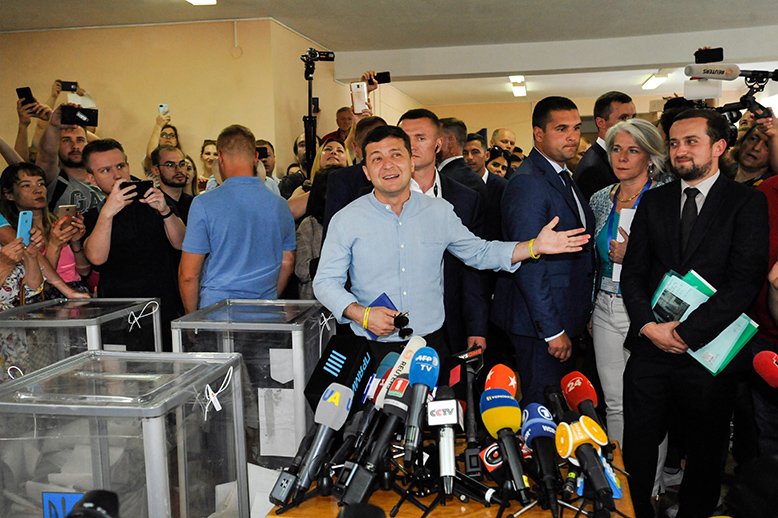 President Volodymyr Zelensky speaks to the media after he voted during the parliamentary election. Photo: Sergei Chuzavkov/Shutterstock
President Volodymyr Zelensky speaks to the media after he voted during the parliamentary election. Photo: Sergei Chuzavkov/Shutterstock
To an even greater extent, however, the election outcome is a reflection of pervasive populist attitudes. The entire Zelensky campaign throughout both presidential and parliamentary races was a major exercise in populism. There is much talk these days of the populist wave sweeping across the West. Thus an intriguing question is how Zelensky compares to Western populist politicians – both left-wing (such as a fellow comedian Beppe Grillo of Italy’s Five Star Movement) and right-wing ones.
Interestingly, the newly elected Ukrainian president appears to represent a distinct, home-grown brand of populism. Zelensky differs from Western left-wing populists in that he seems indifferent to most of the themes that are close to their hearts – such as anti-globalization, anti-capitalism and social justice. His rhetoric is devoid of promises to hit the very wealthy with more tax, redistribute income or increase government spending on social welfare programs. On the other hand, unlike Western right-wing populists, Zelensky does not embrace Euroscepticism, anti-environmentalism and nationalism. In fact, he eschews pursuing any identity politics whatsoever – be it in the form that targets immigrants or other minorities or that extols the virtues of ethnic majority.
Still, the young Ukrainian president is a populist politician par excellence. At the heart of his rhetoric lie signature populist features such as anti-elitist sentiment, opposition to the Establishment and speaking for the “common people.” Furthermore, Zelensky appears fascinated with idea crowdsourcing, referendums and other forms of direct (or “pure”) democracy in which people decide on policy initiatives directly or even set the agenda for government.
It was this idiosyncratic “inclusionary” and “post-ideological” populism devoid of any specific programmatic content that proved irresistible to the great majority of Ukrainians who cast their votes in the latest election cycle, allowing Zelensky to go one better than his sitcom’s fictional protagonist – “people’s president” Vasyl Holoborodko.
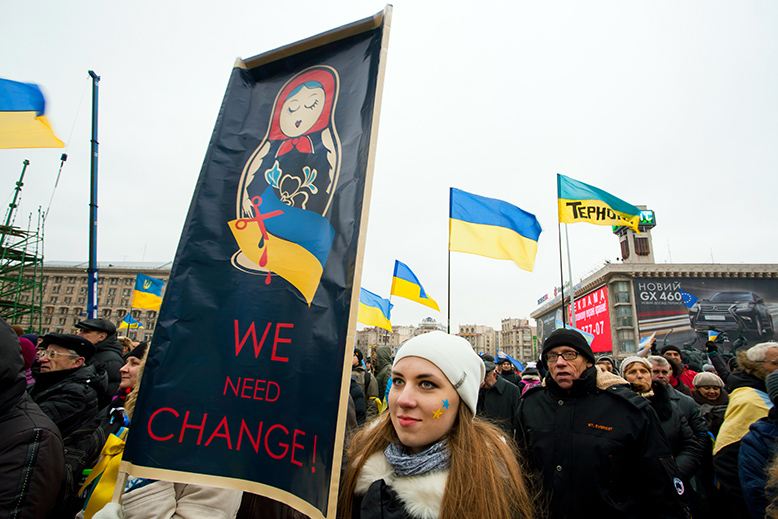 Pro-EU demonstration in Kiev, november 2013. Photo: Radiokafka/Shutterstock
Pro-EU demonstration in Kiev, november 2013. Photo: Radiokafka/Shutterstock
It was the confluence of the strong tradition of popular protest and widespread populist attitudes that catapulted a “Ukrainian everyman” to the pinnacle of power. Tellingly, Osteuropa journal has recently characterized Zelensky as a “man without qualities” – an obvious nod to Robert Musil’s novel Der Mann ohne Eigenschaften and its protagonist Ulrich, whose principal charactristics were lack of any profound essence and ambiguity as a general attitude to life. The journal’s editors have also raised an important question: does the ascendancy of such type of politician indicate politicization or depoliticization of Ukraine’s population? It would seem that the answer is that it’s a combination of both.
There’s no question that Ukrainian society remains highly politicized. “For a contemporary Ukrainian,” the author Sofia Andrukhovych notes in the Süddeutsche Zeitung, “politics is no less important than the most intimate personal affairs, health and relationships with close friends. Political issues break relationships, people become depressed about them or experience emotional roller coaster rides.” At the same time, there are certain signs of depoliticization - in a sense that there is a profound change in the understanding of politics, which seems to be associated less and less with responsible governance. Having elected a political neophyte as their new president and scores of the new MPs who had never been engaged in social activism, argues the political scientist Volodymyr Kulyk, huge numbers of Ukrainians appeared to have rejected politics in the traditional sense or at least have not taken it seriously. Furthermore, even the way politics is done in Ukraine these days is being rapidly transformed. Latest technological developments and the arrival of Ukrainian “smartphone generation” radically simplified and shortened political message, making it fit devices’ screen sizes.
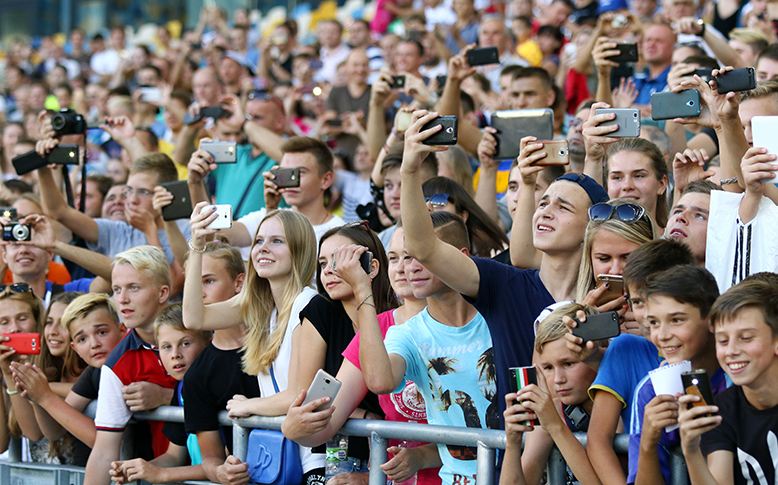 Young football supporters in Kiev watching the National Team. Photo: Shutterstock
Young football supporters in Kiev watching the National Team. Photo: Shutterstock
The 2019 reshaping of Ukraine’s political landscape is a direct result of a powerful blowback from the flawed policies pursued over the last five years by the country’s governing elites, who rode to power on the crest of the 2014 revolutionary wave, and from frustrated expectations of the many millions of Ukrainians. If anything, the outcome of the most recent electoral cycle is a reflection of this land’s famously rebellious spirit. Within the span of less than 30 years of its contemporary history Ukraine has already seen three mighty political upheavals: the emergence of independent state on the ruins of Soviet communist empire, followed by the rise of the corrupt post-Soviet economic and political system; then in 2004 and 2014 there erupted two domestic revolts whose ultimate goal was to rid the country of post-Soviet condition and set it firmly on the path towards European “normality.”
The 2019 protest voting demonstrated the overwhelming majority of Ukrainians are deeply dissatisfied with the current state of affairs. At the same time, the latest elections brought forth a whole plethora of various regional, demographic and socio-economic expectations. Further political turmoil cannot be excluded unless Ukrainian elites clean up their act and pursue structural reforms in earnest.